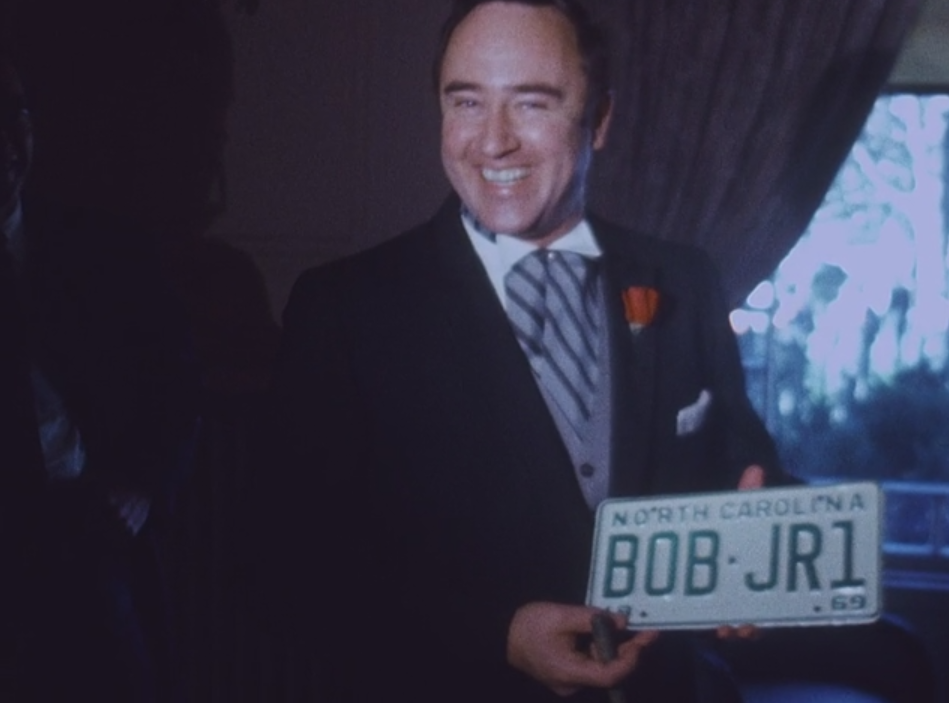
Governor Robert W. Scott receives a “Bob Jr.” license plate in this footage of his inauguration and subsequent celebrations. Contributed by the State Archives of North Carolina.
Almost one year ago, we asked our partners for nominations of audio and video media from their collections to digitize, using funding from the Digital Public Library of America. From all corners of North Carolina came suggestions for moving images and sound. Some items were well documented, with descriptions or finding aids [?] in tow. Others were accompanied with the words “We think this is … but we really have no idea.” Thanks to George Blood, L. P., who digitized these items for us, and Andrea Green, our former Community Digitization Manager, we ended up with over 140 physical items digitized from 11 institutions.
Here’s an overview of what’s been added to DigitalNC to our new Sights and Sounds collection (some of our partners will be posting their digitized media on their own digital collection sites instead). Stay tuned over the next few weeks for more posts taking a closer look at some of our favorites.
Braswell Memorial Library
Throughout the 1990s, Mary Lewis Deans spearheaded an ambitious and well-documented oral history campaign in Nash County. She and her colleagues spoke with long-time residents about rural farming life, military service during World War II, segregation, and family traditions. Deans was businesslike yet friendly, no-nonsense and yet genuine. Listen to and read Deans’ oral histories.
Charlotte Mecklenburg Library
Three of the films contributed by Charlotte Mecklenburg Library help document the history of Charlotte. The Charlotte Mecklenburg United Appeal campaign from 1952 shows numerous Charlotte places.
Davie County Public Library
From Davie County Public Library comes a two-part series on Davie County History, and a home video of local personality Louise Graham Stroud, who performed monologues as her self-created character, “Miss Lizzie.”
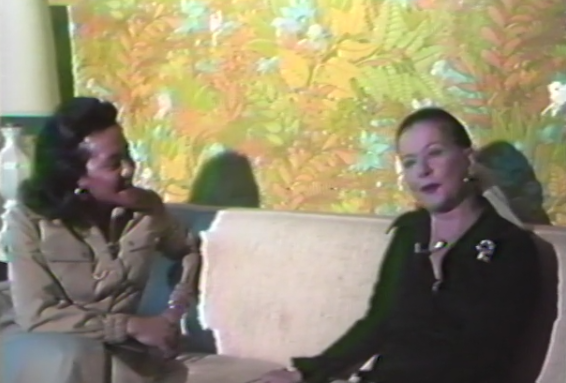
Cynthia Watts (left) interviews actress Joan Bennett in one of the Arts in Durham films contributed by the Durham Public Library.
Durham Public Library
Love Durham? Love the Arts? Love the late 70s? Some of our staff favorites come from Durham Public Library’s collection of “Arts in Durham” films. Produced by the Durham Arts Council, these films showcase local bands, dance groups, visual artists, and more. We’ll definitely be blogging about our favorite moments. Durham Public Library also contributed a taped lecture by Dr. Charles Watts on the history of Lincoln Hospital, and two-part coverage of the Durham County Centennial Parade of 1981.
Edgecombe Memorial Library
Tobacco Perspectives is an amateur recording of a two-night event in the early 1980s during which a historian, a political scientist, and representatives from farm, industry, and public health agencies lectured on the tobacco industry both past and present.
Rockingham County Public Library
We’ve already announced the bookmobile film from Rockingham County, but we’re still looking for someone who can identify the school that’s shown. In this film boys and girls eagerly peruse and check out books from local librarians. It’s even got Jim, the library dog.
State Archives of North Carolina
We were pleased to join for the first time with the State Archives during this project, as they chose a number of films that document the state’s history. Among the films from the Archives that we’ve added online are coverage of Governor R. W. Scott II’s inauguration and U. S. Coast Guard Appreciation Day (1970).
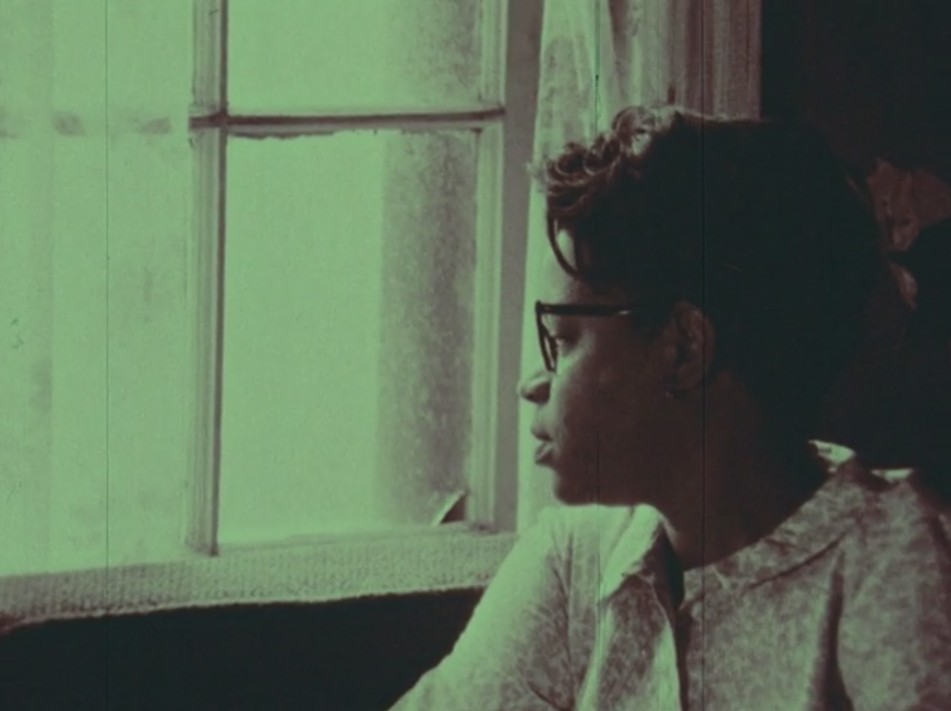
No Handouts for Mrs. Hedgepeth, 1968, documented a Durham family living below the poverty line. Contributed by the North Carolina Collection, UNC-Chapel Hill.
University of North Carolina at Chapel Hill
From 1962-1965, the North Carolina Film Board produced films tackling some of the most pressing issues in North Carolina: race relations, education, and economic opportunity. Eight of those films join others from the North Carolina Collection and Southern Historical Collection at UNC-Chapel Hill on DigitalNC. As might be expected, some are about UNC and Chapel Hill. Fans of the Hugh Morton Collection will also see several films believed to have been filmed by Morton or his colleagues. There’s even footage of Mildred the Bear.
University of North Carolina at Charlotte
In 1960, Dr. Bertha Maxwell-Roddey became the first chair of what is now the Department of Africana Studies at UNC-Charlotte, which contributed three items related to her career. A scholar, educator, and community icon, one of these shows children in a classroom being taught by Maxwell-Roddey’s students. The others show a night of live poetry and music.
We hope you enjoy North Carolina’s Sights and Sounds. Click to view all of the films and oral histories together.

This week we have another 40 titles up on DigitalNC! In this batch we have special editions of Morganton’s The News-Herald that detail the destruction caused to Western North Carolina by “The Great Flood of 1916.”
In July of 1916, two hurricanes hit Western Carolina within a week of each other. The first one came from the Gulf Coast and stalled over the region from the 8th until the 10th, and the second made landfall in South Carolina, reached the mountains on the 15th, and dumped an astounding 22 inches of rain in a 24 hour period.
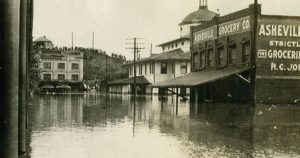
Asheville Grocery, 1916. Image via ourstate.com
After the storms had passed, the Swannanoa River was a mile wide, the French Broad was four times its normal width, there were over 300 landslides, and the town of Hendersonville was surrounded by a lake. At least 80 people died in the flooding, but since so many people lived in rural areas, the exact number is unknown.
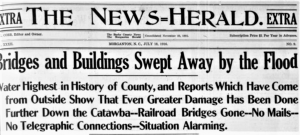
July 18, 1916
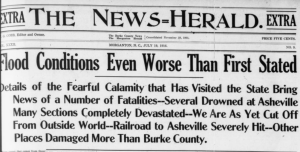
July 19, 1916
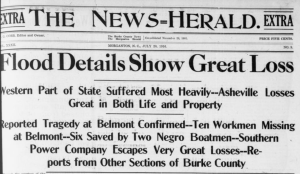
July 20, 1916
Over the next year, we’ll be adding millions of newspaper images to DigitalNC. These images were originally digitized a number of years ago in a partnership with Newspapers.com. That project focused on scanning microfilmed papers published before 1923 held by the North Carolina Collection in Wilson Special Collections Library. While you can currently search all of those pre-1923 issues on Newspapers.com, over the next year we will also make them available in our newspaper database as well. This will allow you to search that content alongside the 2 million pages already on our site – all completely open access and free to use.
This week’s additions include:
- The Liberty Register (Liberty, N.C.) – 1899-1900
- The Kernersville News (Kernersville, N.C.) – 1883-1888
- Jonesboro Leader (Jonesboro, N.C.) – 1888-1892
- Daily Progress (New Bern, N.C.) – 1860
- The Graphic (Nashville, N.C.) – 1899-1925
- The Constitution (Lincolnton, N.C.) – 1880
- The Union Labor Record (Wilmington, N.C.) – 1922-1937
- The Cottage Visitor (Hendersonville, N.C.) – 1869
- Carolina Observer (Fayetteville, N.C.) – 1831-1832
- The Second Century (Albemarle, N.C.) – 1881
- The News-Herald (Morganton, N.C.) – 1902-1922
- The Greenville Index (Greenville, N.C.) – 1894
- Goldsboro Weekly Argus (Goldsboro, N.C.) – 1914-1915
- The Albemarle Enquirer (Murfreesboro, N.C.) – 1886
- Murfreesboro Index (Murfreesboro, N.C.) – 1887-1896
- Piedmont Press (Hickory, N.C.) – 1873-1887
- The Hickory Press (Hickory, N.C.) – 1897-1900
- Randolph Regulator (Asheboro, N.C.) – 1876-1879
- The Randolph Sun (Asheboro, N.C.) – 1878
- North Carolina Bulletin (Asheboro, N.C.) – 1856-1857
- The New North State (Greensboro, N.C.) – 1871-1877
- Greensboro North State (Greensboro, N.C.) – 1886-1891
- The Daily Workman (Greensboro, N.C.) – 1885-1889
- Greensboro Telegram (Greensboro, N.C.) – 1910-1911
- The Weekly Index (Henderson, N.C.) – 1868-1869
- The Henderson Index (Henderson, N.C.) – 1870
- The Hustler (Henderson, N.C.) – 1899
- Evening Herald (Henderson, N.C.) – 1900
- The Henderson News (Henderson, N.C.) – 1887-1888
- The Vance Farmer (Henderson, N.C.) – 1892
- Henderson Daily Dispatch (Henderson, N.C.) – 1916-1923
- Albemarle Sentinel (Edenton, N.C.) – 1839-1840
- Carolina Miscellany (Edenton, N.C.) – 1832
- North-Carolina Miscellany (Edenton, N.C.) – 1833
- The Edenton Clarion (Edenton, N.C.) – 1880-1881
- Edenton Sentinel, and Albemarle Intelligencer (Edenton, N.C.) – 1841
- Albemarle Bulletin (Edenton, N.C.) – 1850-1851
- American Banner (Edenton, N.C.) – 1856
- The Express (Edenton, N.C.) – 1859
- Eastern Courier (Edenton, N.C.) – 1900
If you want to see all of the newspapers we have available on DigitalNC, you can find them here. Thanks to UNC-Chapel Hill Libraries for permission to and support for adding all of this content as well as the content to come. We also thank the North Caroliniana Society for providing funding to support staff working on this project.
Yesterday the North Carolina Digital Heritage Center staff visited the Oliver Nestus Freeman Round House Museum in Wilson, N.C. The museum celebrates African American history in Wilson County and honors the memory of Oliver Nestus Freeman, a local stonemason and builder who had a fascinating life and career.
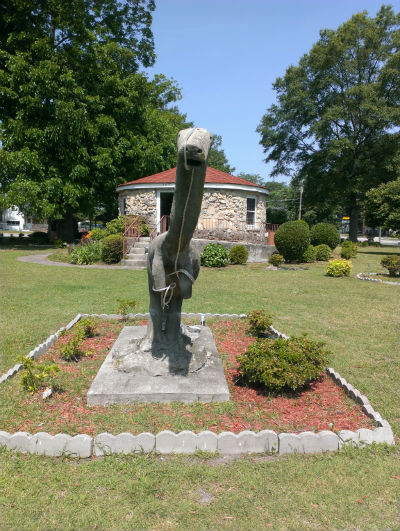
Stone dinosaur created by Oliver Nestus Freeman; Round House Museum in the background. Photo by Kristen Merryman.
Freeman was a Wilson County native, born in 1882. He attended the Tuskegee Normal School where he gained experience in construction and masonry. He returned to Wilson in the 1910s and worked as a mason for decades. He worked on many projects, incorporating a distinctive style using a variety of stones of different shapes and sizes. Many of his projects are still standing in Wilson today.
In addition to his masonry work, Freeman was also known for the animals he kept at his house. The yard was filled with wild birds, rabbits, a goldfish pond, and several small bears. It became a sort of a tourist attraction with residents and visitors stopping by to give peanuts to the bears.
One of Freeman’s most distinctive buildings was the round house he built in the 1940s to rent to veterans returning from World War II. The house had fallen into disrepair by the 1990s when it was chosen by local citizens to serve as a new African American history museum. The house was moved in 2001 to its current location at the intersection of Nash and Hines streets near downtown Wilson. The museum contains photos and documents commemorating African American pioneers and leaders in Wilson and includes a nice display of photos and artifacts from Freeman’s life.
The museum is open for visitors and is well worth a visit next time you’re in or passing through Wilson. There is more information on the their website.
Learn more about Freeman’s work on the North Carolina Architects & Builders site from the North Carolina State University Libraries.
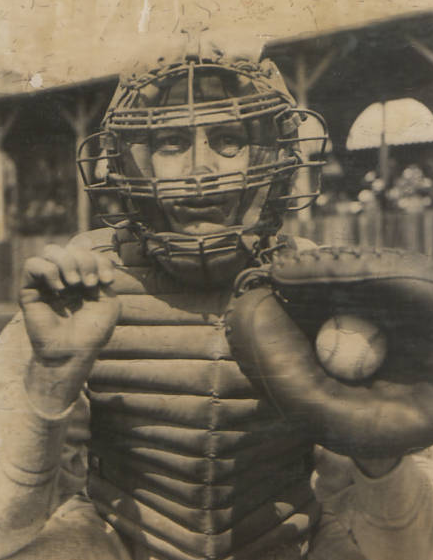 We’ve recently digitized and published online a terrific scrapbook from the local history collection at the Wayne County Public Library. The scrapbook documents the early career of professional baseball player and Wayne County native Johnny Peacock.
We’ve recently digitized and published online a terrific scrapbook from the local history collection at the Wayne County Public Library. The scrapbook documents the early career of professional baseball player and Wayne County native Johnny Peacock.
Peacock was born and grew up in Fremont, N.C., where he excelled in high school sports. He attended the University of North Carolina, playing baseball and football. After graduating from UNC in 1933, Peacock began his professional career in North Carolina with the Wilmington Pirates of the Piedmont League. He continued with minor league teams in Toronto, Nashville, and Minneapolis before making his major league debut with the Boston Red Sox in 1937.
Peacock was a backup catcher throughout his career, never appearing in more than 89 games in a season. He spent parts of eight seasons with the Red Sox and a couple of seasons with the Philadelphia Phillies before finishing his career with the Brooklyn Dodgers in 1945. He retired with a career batting average of .262.

The scrapbook includes clippings and photographs from Peacock’s baseball career from high school through 1939.











